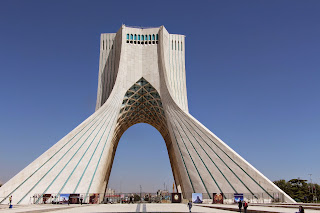Long overdue post on my solo September/October trip to Uzbekistan. Here are the details:
Day 1: arrive in Tashkent at 1935hrs (from Beijing)
Read!
Day 1: arrive in Tashkent at 1935hrs (from Beijing)
Day 2: Tashkent
Day 3: train to Samarkand (high-speed rail which took just 2 hours)
Day 4: Samarkand
 |
| Samarkand's famed Registan |
Day 5: train to Bukhara (took about 6 hours)
Day 6: Bukhara
Day 7: Bukhara
Day 8: morning shared taxi to Nukus, with a change at Beruni (all in all about 8 hours)
 |
| the lone mulberry tree in the courtyard of Kalon Mosque, Bukhara |
Day 9: day trip to Moynaq; Savitsky Museum, a bit of a walk around Nukus
Day 10: shared taxi to Khiva via Urgench (approximately 3 hours)
Day 11: Khiva
Day 12: Khiva
Day 13: Khiva; night flight to Tashkent (Uzbekistan Airways)
Day 14: Tashkent
Day 15: Tashkent
Day 16: Tashkent; flew out at night
Samarkand: 2 nights felt just about right. There are a few places to see in the city.
Bukhara: 2 nights here are good too. It helps that your entrance ticket for a number of sites are good for at least 2 days (ditto Khiva).
Khiva: spend a night here if you don't want to linger too long. Or two nights, provided you leave in the morning.
Tashkent: some interesting architecture (look out for the rocket-looking Banking Association building near Navoiy Park).
Some things to take note of
 |
| Amir Temur Maydoni as seen from Hotel Uzbekistan, Tashkent |
Visa: I'm not sure who won't need a visa to Uzbekistan. It's neighbours and Russia perhaps? :) but depending on which country you come from, you might/not need a letter of invitation before the embassy will process your request. This you can arrange from travel companies such as advantour.com or arostr.com
Flying in: plenty of airlines can get you to Tashkent/Urgench, e.g. Uzbekistan Airways, Aeroflot, Asiana, China Southern, Air Astana
 |
| ceiling work at Tosh Hovli, Khiva |
To/from the airport: taxis are available though you're going to have to haggle before you get into one. I paid 2USD (about 10,000 som on the black market at the time of my visit) for my ride into the city which is about 4-5 km away. Buses and marshrutkas are available right outside once you manage to walk past the many cabbies waiting to pounce on you (ok not quite). Their routes are marked out on a board at the respective bus stops. Note that they operate only till around 10.30pm. If in doubt, ask someone.
Travelling around Tashkent: the city has a pretty good metro system. get a token (1,000 som) at the kassa office. do note that you'll be stopped for bag checks before you're allowed on the platform. Once there, don't even try to take photos. apart from the metro, there are taxis, buses and marshrutkas.
 |
| a mausoleum at Shah-i-Zinda, a UNESCO World Heritage Site |
Inter-city travel: trains are clean and reliable. Tashkent's railway station connects you with most parts of the country. There are buses too but I was told not to bother. Shared taxis are another option, but you'd have to wait till the car is filled to capacity before the driver decides to push off. Flights are available too, which you can book on sites like expedia.com.
 |
| panoramic view of Khiva |
Money: you'll pay for virtually everything in the local currency (soms). You can exchange them from the airport. Problem is, the rate isn't particularly attractive, especially since the black market rate could get you double or more (even if it's illegal to do this). However, refrain from changing from your taxi driver. Pay him in USD (they're usually willing to accept this). Do your exchange at your hotel/guesthouse, or ask them where you can get the black market rate. Then again, you might just find the dealer coming to you instead. Do check to make sure you're getting the right amount. It's not uncommon (especially if you fall into the trap of changing money from cabbies) to find yourself with less than what was agreed, or your stack of notes interspersed with smaller denominations.
Dressing: Uzbekistan may be a Muslim country but it's secular to a fault. Having said that, don't be mistaken into thinking that walking around in a pair of tiny shorts will be ok. To be safe, stick to T-shirts/blouse, jeans/pants, knee-length shorts, or observe how locals dress before toying with the idea of something a little more adventurous.
 |
| Ship Cemetery at what was once the Aral Sea, Moynaq |
What if I don't know Cyrillic: Most places have signs in Russian and Uzbek, the latter being written in Roman alphabets so you shouldn't feel completely helpless. Having said that, you'll definitely find people who can speak English. Most tourist sites/restaurants/cafes would have signs/menus in English. If eating establishments don't, they'd at least be able to verbally tell you what they have (even if it's in halting English).
How safe is it: I found Uzbekistan to be very safe.
Inside Central Asia by Dilip Hiro
The Railway by Hamid Ismailov
Shadow of the Silk Road by Colin Thubron
More images at instagram, @kevusingh

















